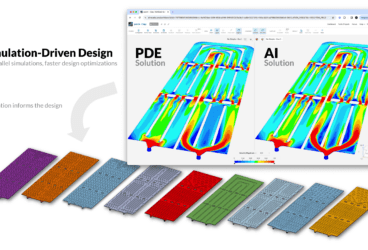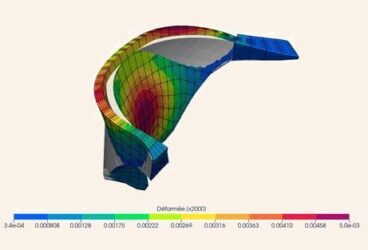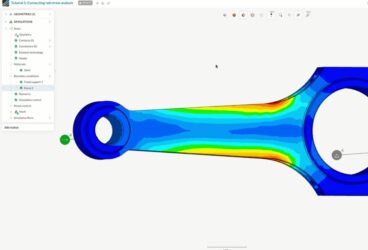The emergence of SaaS solutions and cloud applications have brought the 21st-century innumerous innovations and hope for virtually never-ending possibilities, but it has also created some confusion for many. Cloud-based applications, as an umbrella term, can be broadly split into two categories; cloud-native and cloud-enabled. SimScale, for example, falls into the first category, as we boast cloud-native capabilities built using microservice architecture.

In this article, we will explore the differences between cloud-native and cloud-enabled applications and offerings, highlighting how this subtle differentiation can greatly impact time, cost savings, and efficiency for your company’s operations, as well as which solution offers the greatest amount of flexibility and adaptability in the current dynamic and quickly changing economic environment.
What Does ‘Cloud-Native’ Mean?
All cloud-native applications are indigenous to the cloud, meaning they are only built for and deployed within the cloud environment (without ever stepping foot on the ground!). On a more technical note, these types of applications harness the true power of cloud infrastructure and are hosted as multi-tenant instances (microservice architecture) composed of many different independent modules. So what does this mean?
Characteristics of Cloud-Native Applications:
- Cloud-native applications are innately adaptable and scalable, as modifications can be identified, made, and released to individual modules within the cloud environment in real-time without interrupting the processes of the entire operation/application. This applies to everything from debugging a problem to rolling out new features and regular maintenance and updates.
- Cloud-native applications require no large hardware or software investments, as opposed to on-premises solutions, and are generally available via a license/subscription plan that can be activated in minutes. Adding additional users is typically inexpensive, software updates and the maintenance fees are also avoided, and therefore, cloud-native applications tend to be more cost-effective.
- These types of applications are known for incurring huge time savings, due to the fact that they are easily and quickly implemented as there is no need for aforementioned hardware or software configurations.
Now that we have established what cloud-native applications are and what you can expect from them, let’s discuss the other side of cloud-based tools; cloud-enabled applications.
This paper addresses the difference between on-premises software and SaaS
solutions for computer-aided engineering, explaining how SaaS came to be and its
key benefits.
What Is a Cloud-Enabled Application?
Cloud-enabled differ from cloud-native applications in one crucial way; instead of being created based on cloud-native architecture/microservice architecture, they are created using legacy infrastructure systems. Think of it this way: cloud-native applications consist of modules that have been written with a service-based architecture in mind from the get-go, whereas cloud-enabled applications are created by taking existing software (for example on-premises and desktop applications) and enabling them in some way to utilize cloud computing resources.
Characteristics of Cloud-Enabled Applications:
- Cloud-enabled applications are typically run in-house or using legacy infrastructure, potentially negatively affecting the adaptability and flexibility of these applications because updates and upgrades made to one module could interfere with the entire system.
- Due to their base infrastructure, these types of applications also require and rely on manual upgrades causing disruption and shutdown to the whole application, negatively impacting resources for companies such as time, money, and efficiency.
- Cloud-enabled applications typically incur higher costs, as they require more man-hours from the offering company to accommodate the changing requirements. These applications must be customized for the specific installation environment, and are not a one-size-fits-all solution in most cases.
Cloud-enabled applications are essentially like hybrid cars; boasting some of the same features as fully electric vehicles, or in our case cloud-native applications, but by no means their equivalent. In short, cloud-enabled applications tend to lack the time-savings, cost efficiency, and broad adaptability that their cloud-native counterparts can offer to SMEs and large enterprises alike.
Cloud-Native vs. Cloud-Enabled Conclusions
In the wake of digital transformation, it is clear that the future belongs to cloud-native applications. According to IDC, by 2022, 90% of all new apps brought to market will feature microservices architectures that improve the ability to design, debug, update, and leverage third-party code; 35% of all production apps will be cloud-native.
This estimation parallels the prevalent changing needs of modern firms; a paradigm shift towards tailor-made cloud applications that are readily adaptable and customizable as and per changing projects and cases. With cloud-native architecture at their disposal, enterprises can have an increased concentration on their strategic needs, thus tapping the best of available business opportunities for further growth and success.
Here at SimScale, we offer the first truly cloud-native simulation platform covering CFD, FEA, and thermodynamics evaluation. While many other tools still struggle with adopting the cloud, SimScale is already based on a fully scalable microservice architecture, allowing adaptability, time and cost-savings, as well as collaboration capabilities for our customers. Whether users are new or old to simulation, SimScale’s platform will not only meet current needs, but will adapt to meet future needs as they arise.
Interested in learning more about cloud-native software benefits with SimScale? Look no further:
- Simulation in the Cloud: Tips for a Seamless Migration
- Cloud Migration in 2020: The New Digital Workplace
- The Past, Present, and Future of Cloud Computing and CFD
- SimScale Announces Cloud-Based Collaboration Features
- How to Use Cloud-Based CAD & CFD to Optimize Your Design
- How to Run Non-Cloud Native Services in the Cloud



